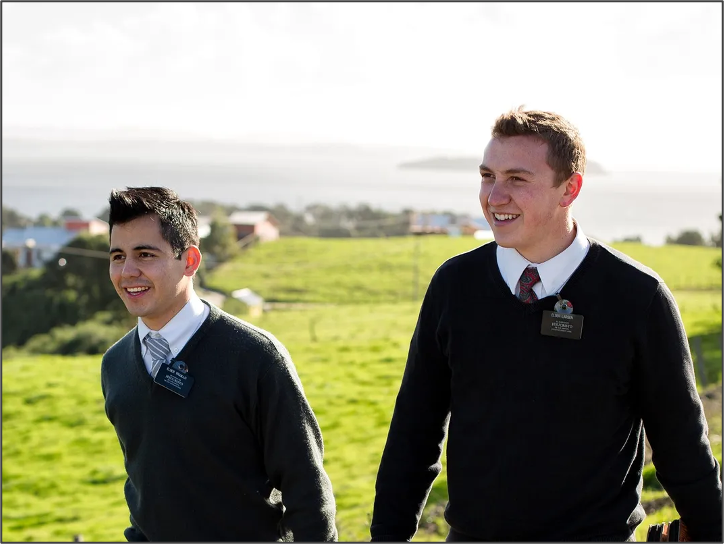I’m happy to announce that a new paper by me, Josh Stevenson, and Wendy Baker-Smemoe called “The Missionary Voice: Perceptions of an Emerging Register” has been published in Proceedings of the Linguistic Society of America! This is based on our LSA presentation in 2023, which ultimately had its origin in Josh Steveson’s BYU Undergraduate Honor’s Thesis. This has been a fun project and I’m excited to see this published.
See Rachel Bowden’s write-up on this article from June 2024 published on the BYU linguistics department website.
See also Jedidiah A. Flores’ article in the Fall 2024 issue of Y Magazine, including a brief video.
Josh started has been explore a particular way of speaking that is typical of missionaries of the Church of Jesus Christ of Latter-day Saints. In fact, in my very first semester at BYU (Fall of 2020), his final paper was on the topic, so he’s been working on this for a while. Later, he had this experience, which he tells in his thesis:
In early January 2022, my sister Megan—then serving as a missionary for the LDS Church in Finland—sent me a voice memo (transcribed below) about another voice memo that she had recently received from a childhood friend who was also on a mission at the time. Megan’s words anecdotally illustrate the sense I’d had that something interesting was happening at the nexus of missionary culture and language: “Oh my gosh Josh, OK [my friend] just sent me a voice memo and I can’t. It doesn’t sound like her. She changed to a “missionary voice.” It is insane. I can’t even explain it. Oh my gosh, like at first I didn’t even recognize it was her. I just want to submit [her] voice memo to you. I can’t even listen to it; it’s painful because she’s so cute but it sounds— (Her voice then trails off.)”
Josh turned this idea into a more complete study as his honor’s thesis by specifically trying to see whether Latter-day Saints can accurately identify a missionary by their voice alone. This study became Study 2 in the PLSA paper that came out this week more-or-less as-is, though in an abbreviated form. The gist is that people generally did not do a good job at guessing whether a person is a missionary or not. For the LSA talk and this paper, we took it a step further though and looked at the voices of people who people thought were missionaries, regardless of whether they actually were. (You can listen to the recordings we analyzed here!) We put together a tentative list of linguistic features that are and are not a part of Missionary Voice. That became Table 2 of the paper.
Around the time Josh was starting his thesis, which I chaired with Wendy Baker-Smemoe as a reader, I was starting some data collection that invovled asking people about various aspects of the Latter-day Saint religiolect, including whether there’s a “Mormonese”, a “Relief Society voice” (more on that later), and a “General Authority voice”. For fun, I threw in a question about Missionary Voice because Josh’s thesis intrigued me and I wanted to see what people might say. I ended up with a lot of really interesting comments. For the most part, people felt like Missionary Voice was generally good, compassionate, lively, and religious. As one person put it, “everything is like a ray of sunshine.” This brief analysis (more like a compilation of adjectives) eventually became Study 1 in the PLSA paper. I think this study really support each other well.
At the end of the paper, we speculated about how Missionary Voice came to be, couched in 3rd Wave sociolinguistic theory. We suspect it originally started as a generic presentation-mode voice, particularly a presentation-mode when the material is memorized. Missionaries are not asked to memorize things now, but the style may have been passed down from more experienced missionaries to less experienced ones in micro-generations, changing along the way and acquiring additional sociolinguistic meaning. As one person put it, “It’s what spiritual discussions are supposed to sound like,” which I think says a lot about its indexicality and, more broadly, how language can shape contexts.


Fun background
I think it’s fun to learn a little background about papers, so here’s a little bit of what happened behind the scenes. Josh finished his thesis and graduated. I encouraged him to submit it to LSA, which he did. I eventually presented for him because when he saw the price tag of LSA’s registration, he decided he wasn’t going to go. I had fun putting the talk together and giving it. But, I didn’t have a clear venue for where to publish it. I had (and still) have a few other higher-priority papers I’d like to send out, so this was low on my to-do list.
Anyway, so around mid-March—I believe it was a Tuesday—I get a regular newsletter from LSA saying, “Hey, if you haven’t submitted your manuscripts to the Proceedings, this week is the last chance to do so!” Apparently I hadn’t been reading previous newsletters carefully enough because that was the first I had heard of it! Well, I figured if I didn’t submit this paper to PLSA, it may never get submitted. So I decided to go for it.
I had a few things with classes that day, but starting Wednesday afternoon, I began writing. I started off with the script from my slides and adapted it to fit a more appropriate style for written papers. About 36 hours later, I had the full manuscript done. I was fortunate to not have anything scheduled on that Thursday, so I spent most of the day writing, going through the original data, and creating a few plots. I sent it to Wendy and Josh for their approval and they made a few tweaks. And then we sent it off! So, that Tuesday morning I had no idea I’d be submitting a paper that week, and by Friday it was done. Wild.